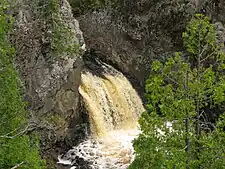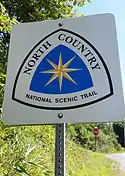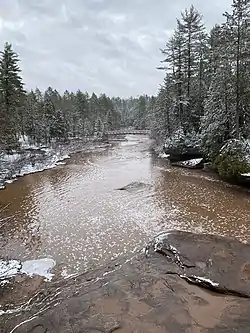North Country Trail
The North Country National Scenic Trail, generally known as the North Country Trail or simply the NCT, is a footpath stretching over 4,800 miles (7,700 km) from Middlebury in central Vermont to Lake Sakakawea State Park in central North Dakota in the United States; connecting both the Long Trail and the Appalachian Trail with the Lewis and Clark Trail. Passing through the eight states of Vermont, New York, Pennsylvania, Ohio, Michigan, Wisconsin, Minnesota and North Dakota, it is the longest of the eleven National Scenic Trails authorized by Congress. As of early 2019, 3,129 miles (5,036 km) of the trail is in place.[1]
| North Country Trail | |
|---|---|
 The North Country Trail in the Manistee National Forest, Michigan. | |
| Length | 4,800 mi (7,700 km) |
| Location | Vermont / New York / Pennsylvania / Ohio / Michigan / Wisconsin / Minnesota / North Dakota |
| Designation | National Scenic Trail (1980) |
| Trailheads | Lake Sakakawea State Park, North Dakota Killington, Vermont |
| Use | Hiking |
| Difficulty | Easy to strenuous |
| Sights | Northern hardwood forest; prairie; agricultural fields; low mountains; sand dunes; boreal forest; lake shores; small towns |
The NCT is administered by the National Park Service, managed by federal, state, and local agencies, and built and maintained primarily by the volunteers of the North Country Trail Association (NCTA) and its partners. The 28 chapters of the NCTA, its 3,200+ members and each affiliate organization have assumed responsibility for trail construction and maintenance of a specific section of the NCT.
History
The NCT was created on March 5, 1980, by an amendment to the National Trails System Act.[2] When the Trail was established in 1980, portions of it were designed to follow the already existing Finger Lakes (New York), Baker (Pennsylvania), and Buckeye (Ohio) Trails. Their sponsoring organizations became affiliates of the North Country Trail Association and agreed to maintain those portions of their trails to be used by the North Country National Scenic Trail. The Northwestern Ohio Rails-to-Trails Association joined later to help create a link between the Buckeye Trail in Ohio and newly constructed trail in Michigan; the Superior Hiking Trail Association, Border Route Trail Association, and the Kekekabic Trail Club joined when it was proposed that the North Country National Scenic Trail route through Minnesota be changed to include an already-completed section of the Superior Hiking Trail along Lake Superior, and the Kekekabic and Border Route Trails along the Canada–US border in Minnesota's Arrowhead Region. Over the years, legislation was introduced in both the U.S. House of Representatives and U.S. Senate which would authorize the Arrowhead re-route as well as later an extension to the trail's eastern terminus, connecting it with the Appalachian Trail in Vermont.[3] On March 12, 2019, the North Country Trail reroute and extension was signed into law as part of the omnibus John D. Dingell Jr. Conservation, Management, and Recreation Act.[4]
Route


The trail begins in Vermont and proceeds to the western end of New York state. It cuts across northwestern Pennsylvania, then follows a southwesterly course through the hilly region of southern Ohio until it nears Cincinnati when it runs north through western Ohio to the hills of SE Michigan. It continues from southeast Michigan through the western Lower Peninsula, crosses the Straits of Mackinac, and takes a northern route the length of the Upper Peninsula. After crossing northern Wisconsin, it follows the Lake Superior shore to the northeast corner of Minnesota before turning west through the Boundary Waters Canoe Area Wilderness, and then southwest to the Chippewa National Forest in central northern Minnesota. The trail enters southeast North Dakota, and continues to its other terminus at Lake Sakakawea in the center of the state.
The NCT connects more than 160 public land units, including parks, forests, scenic attractions, wildlife refuges, game areas, and historic sites. The list includes:
- Ten National Forest areas (Finger Lakes in New York; Allegheny in Pennsylvania; Wayne in Ohio; Manistee, Hiawatha, and Ottawa in Michigan; Chequamegon in Wisconsin; Superior and Chippewa in Minnesota; and Sheyenne National Grassland in North Dakota)

- Four areas of the National Park Service (Michigan's Pictured Rocks National Lakeshore, Wisconsin's St. Croix National Scenic Riverway, New York's Fort Stanwix National Monument, and Ohio's Dayton Aviation Heritage National Historical Park)
Other federal facilities along the NCT include:
- Two National Wildlife Refuges (Minnesota's Tamarac and North Dakota's Audubon), two National Fish Hatcheries (Garrison Dam and Valley City, both in North Dakota), and one Waterfowl Production Area (Minnesota's Prairie Wetlands Learning Center in Fergus Falls)
- Two Bureau of Reclamation projects (North Dakota's Garrison Diversion Unit's New Rockford and McCluskey Canals)
- Seven Army Corps of Engineers impoundments (Lakes Sakakawea and Audubon, Baldhill Dam at Lake Ashtabula, North Dakota, Tom Jenkins Dam and Burr Oak Lake, William H. Harsha Lake [also known as East Fork Lake], Ohio, Tionesta Lake, the Kinzua Dam, and Allegheny Reservoir, Pennsylvania)
- The NCT also shares a short stretch with the Lewis & Clark National Historic Trail at Garrison Dam National Fish Hatchery.
The NCT also threads its way through 57 state parks and state historic areas, 47 state forests, 22 state game areas, seven state water conservation districts and at least ten county forests and parks. Several hundred miles of trail eventually will also cross private land thanks to owners who have granted easements across their property.
The center point of the trail is located near the NCTA headquarters in Lowell, Michigan.
Though the eastern terminus of the North Country Trail is only a few miles from Vermont's Long Trail and the Appalachian Trail, there is not yet a connecting trail to either of those trail systems. Efforts are under way to connect to the Appalachian Trail.[5]
Major Intersections
Listed from west to east.
Western terminus: Lake Sakakawea State Park, North Dakota
.svg.png.webp) ND 200 at Garrison Dam in North Dakota
ND 200 at Garrison Dam in North Dakota.svg.png.webp) ND 200 in Riverdale, North Dakota
ND 200 in Riverdale, North Dakota US 83/
US 83/.svg.png.webp) ND 1804 in Coleharbor, North Dakota
ND 1804 in Coleharbor, North Dakota.svg.png.webp) ND 41,
ND 41, .svg.png.webp) ND 200/
ND 200/.svg.png.webp) ND 41 near Turtle Lake in North Dakota
ND 41 near Turtle Lake in North Dakota.svg.png.webp) ND 41 south of Mercer in North Dakota
ND 41 south of Mercer in North Dakota.svg.png.webp) ND 200 near McClusky in North Dakota
ND 200 near McClusky in North Dakota.svg.png.webp) ND 14 at Lonetree Wildlife Management Area in North Dakota
ND 14 at Lonetree Wildlife Management Area in North Dakota.svg.png.webp) ND 3,
ND 3,  US 52 near Harvey in North Dakota
US 52 near Harvey in North Dakota.svg.png.webp) ND 30 near Hamberg in North Dakota
ND 30 near Hamberg in North Dakota US 281/
US 281/.svg.png.webp) ND 15 in New Rockford, North Dakota
ND 15 in New Rockford, North Dakota.svg.png.webp) ND 20 in McHenry, North Dakota
ND 20 in McHenry, North Dakota.svg.png.webp) ND 65/
ND 65/.svg.png.webp) ND 1 near Binford in North Dakota
ND 1 near Binford in North Dakota.svg.png.webp) ND 65 from near Binford to near Jessie
ND 65 from near Binford to near Jessie.svg.png.webp) ND 65 in Jessie, North Dakota
ND 65 in Jessie, North Dakota.svg.png.webp) ND 45,
ND 45, .svg.png.webp) ND 200 in Cooperstown, North Dakota
ND 200 in Cooperstown, North Dakota.svg.png.webp) ND 26 in Sibley, North Dakota
ND 26 in Sibley, North Dakota
 I-94/US 52 in Valley City, North Dakota
I-94/US 52 in Valley City, North Dakota.svg.png.webp) ND 46 south of Kathryn in North Dakota
ND 46 south of Kathryn in North Dakota.svg.png.webp) ND 32/
ND 32/.svg.png.webp) ND 27 in Lisbon, North Dakota
ND 27 in Lisbon, North Dakota.svg.png.webp) ND 27 in the Sheyenne National Grassland of North Dakota
ND 27 in the Sheyenne National Grassland of North Dakota.svg.png.webp) ND 18 near the Sheyenne National Grassland in North Dakota
ND 18 near the Sheyenne National Grassland in North Dakota
 I-29/US 81 near Colfax in North Dakota
I-29/US 81 near Colfax in North Dakota US 75 in Kent, Minnesota
US 75 in Kent, Minnesota MN 9 near Rothsay in Minnesota
MN 9 near Rothsay in Minnesota

 I-94/US 52/US 59 near Elizabeth in Minnesota
I-94/US 52/US 59 near Elizabeth in Minnesota MN 210,
MN 210,  MN 210 in Fergus Falls, Minnesota
MN 210 in Fergus Falls, Minnesota US 10/
US 10/ MN 87 in Frazee, Minnesota
MN 87 in Frazee, Minnesota MN 34 near Rochert in Minnesota
MN 34 near Rochert in Minnesota MN 113 near Elbow Lake in Minnesota
MN 113 near Elbow Lake in Minnesota US 71 in Itasca State Park in Minnesota
US 71 in Itasca State Park in Minnesota MN 64,
MN 64,  MN 34,
MN 34,  MN 371 near Walker in Minnesota
MN 371 near Walker in Minnesota MN 84 near Longville in Minnesota
MN 84 near Longville in Minnesota MN 200,
MN 200,  MN 6 near Remer in Minnesota
MN 6 near Remer in Minnesota US 169,
US 169, 
 US 2/US 169 in Grand Rapids, Minnesota
US 2/US 169 in Grand Rapids, Minnesota US 169,
US 169,  US 169 in Pengilly, Minnesota
US 169 in Pengilly, Minnesota MN 65 in Nashwauk, Minnesota
MN 65 in Nashwauk, Minnesota US 169/
US 169/ MN 73 in Hibbing, Minnesota
MN 73 in Hibbing, Minnesota US 169 in Chisholm, Minnesota
US 169 in Chisholm, Minnesota US 53/
US 53/ MN 135,
MN 135,  MN 135,
MN 135,  MN 135,
MN 135,  US 53/
US 53/ MN 135,
MN 135,  US 53/
US 53/ MN 135 in Virginia, Minnesota
MN 135 in Virginia, Minnesota MN 135/
MN 135/ MN 37 in Gilbert, Minnesota
MN 37 in Gilbert, Minnesota MN 135 in Biwabik, Minnesota
MN 135 in Biwabik, Minnesota MN 135 from near Aurora, Minnesota to Tower, Minnesota
MN 135 from near Aurora, Minnesota to Tower, Minnesota MN 1/
MN 1/ MN 169 in Soudan, Minnesota
MN 169 in Soudan, Minnesota VT 73 at Brandon Gap in Vermont
VT 73 at Brandon Gap in Vermont
Eastern terminus: ![]() Appalachian Trail, Maine Junction, Vermont
Appalachian Trail, Maine Junction, Vermont
Trail progress by state
North Dakota
- Lake Sakakawea State Park
- Garrison Dam National Fish Hatchery
- City of Riverdale, North Dakota
- Audubon National Wildlife Refuge
- Brekken-Holmes Recreation Area
- Chain of Lakes Recreation Area
- Lonetree Wildlife Management Area
- Lake Ashtabula, North Dakota
- Valley City, North Dakota
- Clausen Springs Recreation Area
- Fort Ransom State Park
- Sheyenne River State Forest
- City of Lisbon, North Dakota
- Biesterfeldt National Historic Landmark
- Sheyenne National Grassland
- City of Abercrombie, North Dakota
- Abercrombie State Historic Site
Minnesota
- There is a 10-mile loop within the City of Fergus Falls
- There is a short segment within Maplewood State Park, within Vergas, and within Frazee
- There is a long, contiguous segment from just south of State Highway 34 all the way to State Highway 6 near Remer. This section passes through Hubbell Pond Wildlife Management Area, Tamarac National Wildlife Refuge, Becker County Forest, the White Earth State Forest, Clearwater County Forest, Itasca State Park, Hubbard County Forest, Paul Bunyan State Forest, and the Chippewa National Forest.
- Superior Hiking Trail
- Border Route Trail
- Kekekabic Trail
- Mesabi Trail - the Mesabi Trail will serve as a temporary connector route of the NCT in between Coleraine and Ely while the primitive, off-road trail is planned and built.
Ohio

New York
Use
Existing and new sections of the NCT are generally limited to foot travel, including hiking, snowshoeing and cross-country skiing. Other non-motorized uses, such as bicycling and horseback riding are generally limited to areas specifically designed to withstand such use.
About 10,000 people are involved with the NCT in one way or another, either through membership in the North Country Trail Association or membership in one of eight organizations affiliated with the NCTA: the Finger Lakes Trail Conference, the Buckeye Trail Association, the Superior Hiking Trail Association, the Kekekabic Trail Club, the Northwestern Ohio Rails-to-Trails Association, the Butler Outdoor Club, the Rachel Carson Trails Conservancy and the Friends of the Jordan River National Fish Hatchery.
Gallery
 A trail post that includes the trail's official logo
A trail post that includes the trail's official logo Blue blazes, where allowed, mark the path of the North Country Trail
Blue blazes, where allowed, mark the path of the North Country Trail Sign in Wisconsin
Sign in Wisconsin Trail bridge crossing the Baltimore River at O Kun de Kun Falls in Michigan
Trail bridge crossing the Baltimore River at O Kun de Kun Falls in Michigan A blue blaze marking the trail painted on a tree near Traverse City, Michigan
A blue blaze marking the trail painted on a tree near Traverse City, Michigan Signpost in Moraine State Park, Pennsylvania
Signpost in Moraine State Park, Pennsylvania
References
- "2018 North Country Trail Progress Report". 2018. Retrieved February 11, 2019.
- "Public Law 96-119" (PDF). US Government Publishing Office. March 5, 1980. Retrieved March 4, 2017.
- "NCNST Route Adjustment Act Advocacy Update". North Country Trail Association. February 14, 2017. Retrieved March 5, 2017.
- Murkowski, Lisa (March 12, 2019). "Text - S.47 - 116th Congress (2019-2020): John D. Dingell, Jr. Conservation, Management, and Recreation Act". congress.gov. Retrieved April 2, 2019.
- Associated Press (June 25, 2012). "Efforts under way to link Appalachian Trail with 4,600-mile trail to ND, nation's longest". The Washington Post. Retrieved June 25, 2012.
- "Welcome to Wabash Cannonball Trail". Retrieved April 3, 2016.
- "National Park Service, North Country Trail". Retrieved April 3, 2016.
- "Buckeye Trail Association - Hike Ohio". Retrieved October 1, 2020.
- "Explore the Trail - North Country Trail Association". Retrieved October 1, 2020.